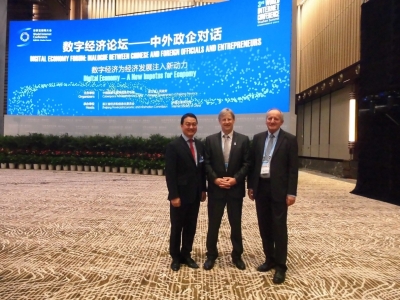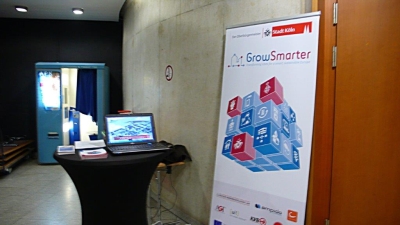GrowSmarter has reached a milestone year: by the end of 2017, all the smart solutions will be in place and in use in Stockholm. Smart solutions from each area of action have already been implemented, so the work is now shifting from implementation to demonstration and evaluation of the project. A lot of emphasis is put on communication and marketing activities in 2017 and 2018. Each partner will make a communication plan and contribute to the demonstration site’s general communication activity plan, but also look into how the smart solutions can be marketed internationally.
Action area 1: Low-Energy Districts
To see all the measures to be implemented, click here.
What’s happening in Valla Torg, Årsta and the Slakthus area buildings?
The smart solutions for low energy districts will be rolled out in the building zones in Valla Torg, Årsta and the Slakthus area (see map here). For an overview of the measures being implemented, click here.
In Valla Torg The refurbishment of the first higher storey building (7G) started in September 2016. Insulation of facades, installation of new windows and other climate shell related measures were carried out by Skanska.
The refurbishment of the first lower storey building (8H) started in October 2016. Work on insulating facades and changing windows has already been done, and other climate shell measures will be finalised by the end of March 2017.
The refurbishment of the second higher storey building (6F) started in December 2016. All of the measures to be implemented are part of the energy efficient climate shell (solution 1).
In the private condominia, Brf Årstakrönet, the implementation (solution 1) and (solution 3) started in January 2016 with the installation of an adaptive control system by Veolia. Veolia has also installed photovoltaic arrays (solution 4) on the roofs. The solar energy production is connected with energy storage (batteries), so that solar energy can be stored and used when it’s needed. The same solutions will also be implemented in the Slakthus area buildings during later stages of refurbishment.
In Slakthus the refurbishment of building 8 by the Fastighetskontoret (Real Estate Administration Office) started in October 2016. Unfortunately, the overall budget for the Real Estate Administration was cut, so the second building (building 7) cannot be refurbished in 2017 as planned. Therefore, we are working on finding a replacement building. The alternative building will also be situated in Slakthus area.
Action area 2: Integrated infrastructures
To see all the measures to be implemented, click here.
Installing smart LED-lighting
As described in an earlier blog, the installation of smart LED-street lights (solution 5) was finalised in June 2016 in Valla Torg and has now been in use for a full winter season. The measure will bring an estimated 50% energy savings, but actual figures have not yet been analysed.
A Smart Connected City
In Stockholm the smart connected city will use the extensive fibre optic network provided and administered by Stokab, a company owned by Stockholm City Council. Several Internet of Things applications and solutions can be built on top of the network.
In April 2017 sensors will be installed in the Slakthus area. One set of sensors will measure the pedestrian and bicycle traffic in the area. Another set of sensors will analyse vehicle traffic. We are especially interested in understanding how people travel to events that take place in this area: there are three sports arenas situated close to each other which host events year-round.
We will also install sensors for measuring air pollution. These will be placed in the same locations as the vehicle transport sensors. The real-time data that is collected will be delivered to an open consolidated big data platform for further analysis. A workshop with city departments and other interested parties is planned for the 8th of March to define the types of analysis to be done. Later in spring when the first set of data has been analysed, further workshops will be planned to define what kind of applications can be developed for lowering transport-based emissions based on the real-time data. In doing this we are defining ways to provide higher quality of life for citizens with smart connected solutions.
IBM, who are responsible for the open consolidated big data platform (solution 8), have two ongoing roles in GrowSmarter: “Sensing City Scale people movement” and “Movement of Pedestrians/Bicyclists”.
Under “Sensing City Scale people movement” IBM will analyse data on the flow of people to show how people move in the Slakthus area over time by creating heat maps. This analysis will be combined with other data such as public transport capacity, traffic measurements, weather, etc. to see how well the different transportation modes and capacities are optimised in the area, especially during events with a lot of people in motion. The project team, platform for data management, analysis tools and method are all already in place.
In “Movement of Pedestrians/Bicyclists” IBM will measure and study in detail specifically how pedestrians move in the city. A prototype user interface environment has been developed on the Bluemix platform. Sample data sets from relevant data sources have been uploaded into the Bluemix environment and made available for users, including vehicle traffic measurement data, bicycle traffic measurement data, bicycle accident data, and weather data for specific locations in the city. End user functions and graphical visualisation tools have been developed.
Together with the Traffic Administration, a plan for implementing new sensor data sources has been made. There will be 7 video sensors in the city connected via the fibre optic network to the Bluemix platform, which will feed into the traffic planner user environment in Bluemix. These sensors will be able to measure the flow, volume and direction of pedestrians, cyclists and vehicles in the selected city areas covered.
Waste Heat recovery
Fortum’s open district heating (solution 6) will be implemented in two locations. In Västberga, waste heat from data centres will be integrated into the district heating system.The same will be done for waste heat from Supermarkets in Farsta (some 5km south of the Slakthus area). The agreements have been signed and the installation in the Supermarket is completed. Due to delivery problems the heat pump could not be delivered as planned in March, so the installation in the data centre is postponed until June. When the solutions are in operation, the waste heat collected can be distributed into the district heating system and provide heat and hot water to more than 1,000 apartments.
Smart waste Handling
The waste handling system provided by Envac will be completed in June this year, with the terminal and inlets being installed during spring 2017. The different waste types will be separated by tenants into different coloured bags. The tenant places the bags in the inlet, and each bag colour is automatically identified and measured. Data from all six buildings in the project will be collected. The waste is then transported in underground pipes to the terminal. From the terminal the waste bags are sent to the sorting facility, where the different coloured bags are separated for recycling.
The smart waste handling has several benefits. It saves space compared to conventional waste containers, which can then be used for other purposes. The system also brings about benefits for hygiene and reduces bad odours. As the waste is piped to the terminal for collection, traffic for collecting waste at buildings will be reduced, meaning reduced traffic emissions but also less noise at residential buildings.
Action area 3: Sustainable Urban Mobility
To see all the measures to be implemented, click here.
Building logistics center and delivery boxes
The building logistics centre (solution 2), implemented by Carrier, started in September 2016 with the delivery of windows to Valla Torg. Carrier is together with Skanska discussing which material streams can be best handled by the logistics centre. The construction logistics are part of the production process, so the better production is planned and organised, the easier it is to provide just-in-time deliveries to construction sites. The materials are delivered outside work hours (after 5pm) so that they are available in the next morning at the construction site.
The implementation of delivery boxes (solution 9) by Carrier will be done in three buildings as part of the 2017 refurbishment plan in Valla Torg. Tenants can order packages and other deliveries straight home instead of picking them up from the nearest service point. The delivery from the service point to the building is done by cargo bikes.
Smart Traffic Management
Insero, together with NOAE (Network of Automotive Excellence) and Global car OEM, is implementing an information system for drivers (solution 10). In Stockholm ten traffic lights are equipped with software that can communicate and relay information about the status of the light and when it is about to switch. This is achieved through a data connection between the traffic light, the cars’ onboard software and GPS, and a central computer handling the calculations. Through a special device in the car, the driver will receive information about what speed to drive in order to reach a green light at the next junction. This information tool will be tested in two cars starting in March 2017. Effects on travel time and the drivers’ experiences will be evaluated.
KTH has together with Info24 (now Tingcore) developed a smartphone application (solution 10) to study changes in travel behaviour in a way that is more effective and has a greater response rate than traditional travel surveys. This will improve the travel demand management measures. In the same application, information about renewable fuels in Stockholm will be shown. This information contains updated information on where each alternative fuel can be tanked, together with most recent price.
Alternative fuel driven vehicles
As part of the GrowSmarter project, Fortum has planned to install up to 10 charging stations and one fast charger (solution 11). The fast charger is installed in Årsta. The normal chargers will be installed in Valla Torg, Slakthus area and Årsta during 2017.
The first refuelling station (solution 11) for renewable fuels is up and running. The filling station in Årsta is expected to be installed in the beginning of 2018.
Communication and marketing
In Stockholm several study visits have been arranged and there is a great interest in the GrowSmarter solutions. As more and more smart solutions are implemented, the study visits will become more frequent. In August 2017 there is a plan to have an event demonstrating the smart solutions in Valla Torg. Here the focus is on city representatives. In November/December 2017 a similar event will be arranged in the Slakthus area. In spring 2018 an event is planned for tenants in Valla Torg.
All Stockholm partners will produce their own communication activities plan in April, and contribute to an overall communication activities plan for the Stockholm site. In addition, the partners will start producing a marketing plan for their smart solutions as soon as the implementation is completed.
Mika Hakosalo
Site Manager, Stockholm



















